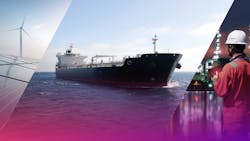Edda wind service vessel to stage green hydrogen trial
Offshore staff
ERLANGEN, Germany — The Ship-aH2oy project will develop a zero-emission propulsion technology on board ships using green hydrogen from a liquid organic hydrogen carrier (LOHC) on a megawatt scale.
The concept, based on the combined use of LOHC and solid oxide fuel cells (SOFC) as a powertrain, will be demonstrated on board one of Edda Wind’s commissioning/service operation vessels.
Hydrogenious’ LOHC technology, with the thermal oil benzyl toluene as the carrier material, is said to enable safe handling of hydrogen at ambient conditions.
The gaseous hydrogen molecules are bound to and released from the carrier in a chemical catalytic process (hydrogenation/dehydrogenation), without self-discharge over time. The carrier’s non-explosive, hardly flammable features (according to Hydrogenious) mean the potential for hazards is smaller than for diesel and superior to ammonia.
Under the Ship-aH2oy project, the company will supervise detailed design of the LOHC release unit and the integration with the service vessel, also interfacing with the SOFC supplier and supporting installation on the Edda Wind vessel.
Østensjø Rederi, as project manager for the newbuilds responsible for the interface and machinery space contributions, will demonstrate with ship owner Edda Wind operation of the onboard power plant using green hydrogen.
The Ship-aH2oy partners have plans to retrofit several other vessels with LOHC/SOFC
Øystein Skår, general manager at Hydrogenious LOHC Maritime, said, “Within the Ship-aH2oy project, we will enter the range of megawatt drive power provided by emission-free LOHC technology. This depicts a relevant power range for a wide operation range of service operation vessels and other ship types. Thus, in Ship-aH2oy a significant reduction of greenhouse-gas emissions can be achieved for a specific ship. Moreover, the project is a large step toward the serial production of onboard LOHC power systems in the megawatt range.”
02.02.2023
